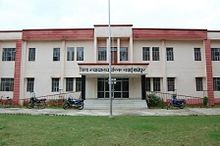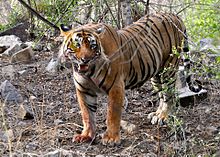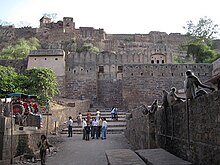Sawai Madhopur
hideThis article has multiple issues. Please help or discuss these issues on the talk page. (Learn how and when to remove these template messages)
|
Sawai Madhopur
Madhopur | |
|---|---|
City | |
 Hills around the old city and the Ghataliya Balaji temple | |
| Nickname(s): Tiger city | |
 Sawai Madhopur Location in Rajasthan, India | |
| Coordinates: 25°59′N 76°22′E / 25.983°N 76.367°ECoordinates: 25°59′N 76°22′E / 25.983°N 76.367°E | |
| Country | |
| State | Rajasthan |
| District | Sawai Madhopur |
| Founded by | Sawai Madho Singh I |
| Named for | Himself |
| Government | |
| • Type | Municipal Council |
| • Body | Sawai Madhopur Municipal Council |
| Area | |
| • Total | 59 km2 (23 sq mi) |
| Elevation | 257 m (843 ft) |
| Population (2011)[3] | |
| • Total | 121,106[1] |
| • Density | 297/km2 (770/sq mi) |
| Time zone | UTC+5:30 (IST) |
| PIN | 322001 |
| Telephone code | 07462 |
| Vehicle registration | RJ-25 |
| Sex ratio | 922 per 1000 ♂/♀ |
| Website | sawaimadhopur.rajasthan.gov.in |
Sawai Madhopur is a city and Municipal Council (Nagar Parishad) in the Sawai Madhopur District in Rajasthan state, India. It is the administrative headquarters of Sawai Madhopur District of Rajasthan.Sawai Madhopur District comes under Bharatpur Divisional Commissionerate.[4] Near to Sawai Madhopur is the Ranthambore National Park which is 7 km from the railway station and Ranthambore Fort, a UNESCO World Heritage Site.
History[]
Sawai Madhopur was built as a planned city by Maharaja Madho Singh I of Jaipur (1751 – 1768) and is named after him.[5] Construction began on 19 January 1763 and Sawai Madhopur celebrates its foundation day annually.
The Sawai Madhopur Lodge, now a hotel, survives as a relic of the days of tiger hunting. The lodge was built in 1936 by Maharaja Man Singh II (1912 – 1971) and used as a hunting lodge until his death. The two-story building is constructed in a crescent shape with a long verandah.[6] Queen Elizabeth of England visited the lodge in January 1961.[7]
Geography[]
Sawai Madhopur is located in southeast Rajasthan. The city is approximately 121 kilometres (75 mi) southeast of Jaipur.[8]
Climate[]
Sawai Madhopur has a subtropical, dry climate with distinct winter, summer and rainy seasons. The highest temperature occurs between May and June up to 49 °C (120 °F). The lowest temperature occurs between December and January, down to 2 °C (36 °F) The average rainfall in Sawai Madhopur is 800 mm with a monsoon season from July to October when Ranthambore National Park is closed. In summer, the average humidity is 10 to 15 percent and 60 percent in the rainy season. The ideal tourist season is from November to May.
| hideClimate data for Sawai Madhopur (1981–2010, extremes 1969–2012) | |||||||||||||
|---|---|---|---|---|---|---|---|---|---|---|---|---|---|
| Month | Jan | Feb | Mar | Apr | May | Jun | Jul | Aug | Sep | Oct | Nov | Dec | Year |
| Record high °C (°F) | 32.9 (91.2) |
36.6 (97.9) |
42.2 (108.0) |
46.5 (115.7) |
48.0 (118.4) |
48.0 (118.4) |
46.3 (115.3) |
40.0 (104.0) |
40.9 (105.6) |
41.0 (105.8) |
36.7 (98.1) |
32.0 (89.6) |
48.0 (118.4) |
| Average high °C (°F) | 23.4 (74.1) |
27.4 (81.3) |
33.7 (92.7) |
39.3 (102.7) |
42.3 (108.1) |
40.4 (104.7) |
34.3 (93.7) |
32.3 (90.1) |
34.3 (93.7) |
34.4 (93.9) |
29.9 (85.8) |
24.9 (76.8) |
33.1 (91.6) |
| Average low °C (°F) | 7.5 (45.5) |
10.7 (51.3) |
16.5 (61.7) |
22.3 (72.1) |
26.9 (80.4) |
27.3 (81.1) |
24.7 (76.5) |
23.5 (74.3) |
22.9 (73.2) |
18.4 (65.1) |
13.3 (55.9) |
9.1 (48.4) |
18.6 (65.5) |
| Record low °C (°F) | −1.0 (30.2) |
−1.2 (29.8) |
3.5 (38.3) |
9.3 (48.7) |
14.6 (58.3) |
15.0 (59.0) |
11.5 (52.7) |
16.4 (61.5) |
14.0 (57.2) |
6.8 (44.2) |
2.5 (36.5) |
1.0 (33.8) |
−1.2 (29.8) |
| Average rainfall mm (inches) | 7.2 (0.28) |
6.6 (0.26) |
4.2 (0.17) |
7.3 (0.29) |
11.8 (0.46) |
61.5 (2.42) |
236.7 (9.32) |
263.4 (10.37) |
101.5 (4.00) |
29.5 (1.16) |
11.4 (0.45) |
3.5 (0.14) |
744.5 (29.31) |
| Average rainy days | 0.6 | 0.8 | 0.5 | 0.6 | 1.1 | 3.8 | 10.3 | 11.2 | 5.1 | 1.3 | 0.5 | 0.3 | 36.1 |
| Average relative humidity (%) (at 17:30 IST) | 45 | 34 | 27 | 22 | 23 | 36 | 62 | 68 | 55 | 41 | 42 | 47 | 42 |
| Source: India Meteorological Department[9][10] | |||||||||||||
Demographics[]
| Year | Population |
|---|---|
| 1991 | 72,165
|
| 2001 | 101,997
|
| 2011 | 121,106
|
In the India census of 2011,[11] Sawai Madhopur had a population of 121,106. Females counted 47 percent of the population and males 53 percent. Sawai Madhopur has an average literacy rate of 79.44 percent which is greater than the national rate of 74.04%. Female literacy (67.98 percent) is less than the male literacy rate (90.09 percent). In Sawai Madhopur, 12.89 percent of the population is under 6 years of age.[12] Sawai Madhopur includes Jat, Gurjar and Meena population.[13]
Religion[]
Most people in Sawai Madhopur are Hindu. Just over 20 percent are Muslim. Christians are very small minority. In Sawai madhopur 44% are Meena Community and 12 percent Gurjar. Mainly there are two caste dominant Meena and Gurjar.[12]
Governance[]

The Nagar Parishad of Sawai Madhopur is the body responsible for the town's civil works and administration. The Municipal Corporation is headed by a chairman. Each of 60 wards is represented in the Municipal Corporation by an elected member. The Urban Improvement Trust (UIT) of Sawai Madhopur is the government agency responsible for the planning and development of the town.
Sawai Madhopur is one of four Assembly Constituencies within Sawai Madhopur District. The others are Gangapur, Bamanwas and Khandar. Sawai Madhopur lies in the Tonk-Sawai Madhopur Parliamentary Constituency. The political representative (MLA) of Sawai Madhopur is Dhanish Abrar. The Member of Parliament (MP) from Tonk-Sawai Madhopur Parliament Constituency is Sukhbir Singh Jaunapuria.
Economy[]
The economy of Sawai Madhopur is based in agriculture and hospitality. Factors affecting the economy have included the closure of a cement factory and the instituting of regulations protecting forests and the ecosystem. There are no large scale manufacturing plants in the town.
Guava is grown around Sawai Madhopur. In 1985, the first guava in the area was grown on a farm of five hectares in Karmoda Village. In 2015, the retail and the wholesale markets of Guava generated more than 5 billion rupees. In 2015, five thousand hectares of land were dedicated to cultivating guava.[14]
Other products from the region include those used for the extraction of essential oils and traditional medicines.
Fairs and festivals[]

Sawai Madhopur Utsav[]
The Sawai Madhopur Utsav is the annual celebration held on the foundation day of the city of Sawai Madhopur on 19 January. It is the day on which the city of Sawai Madhopur was established by Maharaja Sawai Madho Singh I in 1763.[15]
The Ganesh Chaturthi Fair is the largest of Sawai Madhopur's fairs. It is celebrated over three days on Bhadav Shukla Chaturthi at the Ganesh Temple at the Ranthambhore Fort. Dussera is celebrated in Sawai Madhopur for 10 days in the month of October.
The Chauth Mata Mela fair is held in the month of January, at Chauth Mata temple in Chauth ka Barwara.
Culture[]
The languages commonly spoken in Sawai Madhopur are English, Hindi and Dhundari.
Typical dishes in Sawai Madhopur include Dal Baati Churma, Gatte ki sabzi, Bajre ki roti and Dal bade. The sweet dishes includes Kharbuje ka laddoo.
The types of dances performed in Sawai Madhopur include the Ghoomar dance, the Sawai Madhopur dance and the Kalbeliya dance.
Places of interest[]
Ranthambore National Park[]

Ranthambore National Park is one of the largest national parks in India. It is situated about 11 kilometres (6.8 mi) from Sawai Madhopur. In 1955, it was established as the Sawai Madhopur Game Sanctuary. In 1973, the land became a Project Tiger reserve. The area was renamed the Ranthambore National Park in 1980. In 1984, the adjacent forests were declared the Sawai Man Singh Sanctuary and Keladevi Sanctuary, and in 1991 the tiger reserve was enlarged to include Sawai Man Singh and Keladevi sanctuaries.
Ranthambore Fort[]

The history of Sawai Madhopur is associated with the Ranthambore Fort. The date of its construction is unknown. The fort provides an oasis in an area of arid land. In medieval times, it was a defence against the forces such as those of Delhi and Agra. In 1296 CE, held the fort. Notable features of the fort include the Toran Dwar, Mahadeo Chhatri, Sameton Ki Haveli, the 32 pillared Chhatri, Mosque, and Ganesh Temple.
Chauth mata[]
Largest temple of chauth mata is located in Chauth Ka Barwada, Sawai Madhopur. Chauth mata is {Kuldevi} of Meena's Community. The Chauth Mata Mandir is located on a hilltop of town Chauth Ka Barwada, 35 km from Sawai Madhopur district of Rajasthan state, which was founded by King Bhima Meena in 1451 AD. Chauth Mata Temple is one of the most prominent temples of Sawai Madhopur in Rajasthan.
Meen bhagwan[]
This temple dedicated to Lord Meenesh i.e. Matsyavatar is located in the town of Chauth Ka Barwara of Sawai Madhopur district in the Rajasthan state of India. This grand temple built with the support of Meena Samaj of Barwara area of Chauth is not simple but is equipped with all modern facilities. The 108 feet high dome of this temple of Lord Meenesh remains the main attraction of the people. Generally, largest temple of meen bhagwan is located in Chauth Ka Barwada, Sawai Madhopur. In temple there is also dharmshala of Meena community. The whole temple is made up of white marble and ruby are also fit in makbara. Meena community are donated 7 Crore to temple and this temple is built without any help of government. This temple is built from the support of Meena Community.
Rajiv Gandhi Regional Museum of Natural History[]

On 23 December 2007, the foundation stone laying ceremony of Rajiv Gandhi Regional Museum of Natural History in Sawai Madhopur, was officiated by Hamid Ansari, Vice President of India. The museum focusses on the environment of the western arid region of India.

Chamatkarji Jain temple[]
Chamatkarji Jain temple is located in Alanpur village. The temple dates back to early medieval period. The temple is built in Pancharatha style with main shrine housing the idol of Rishabhanatha.[16]
Shilpgram[]
Shilpgram is Sawai Madhopur's rural arts and crafts complex. It is a living ethnographic museum of the West Zone of India which includes five federal states. Special emphasis is laid on workshops for children on arts, crafts, theatre, and music.
Temples[]
The Galta temple is a historic Shri Ram-Sita temple situated in the old city. Guavas are grown in the 40 km region around the city. Balaji of Itawa village it is a very popular and famous temple.
Education[]
Institute of Hotel Management[]
On 1 September 2015, the Government of India officiated an Institute of Hotel Management at Sawai Madhopur to develop the hospitality sector and to promote tourism.[17]
Colleges[]
- Institute of Hospitality Management
- Sawai Madhopur College of Engineering and Technology
- Government PG College
- Government Polytechnic College
- Gulshan College of Nursing
Organizations and NGOs[]
- Gramin Shiksha Kendra
- Dastkar Ranthambhore
- Princess Diya Kumari Foundation
- Prakritik Society
- Access Development Services - works with local farmers and women artisans.[18]
- 2nd Inning Naya Savera Old age home
Transportation[]
Air[]
Sawai Madhopur has an airstrip which is used for Private Jets and Supreme Airlines has started regular flight operations between Sawai Madhopur and Delhi from 11 April 2018.[19] The nearest airport is the Jaipur International Airport 132 kilometres (82 mi) away.
Rail[]

Sawai Madhopur Junction is located on the Delhi to Mumbai trunk route. The city is a stop for many trains, including Jaipur - Indore Super-Fast, Dayodaya Express (Ajmer - Jabalpur Express), Jodhpur - Indore Intercity, Hazrat Nizamuddin - Indore Express, Marusagar Express (Ajmer - Ernakulam Express / Ernakulam Express), Jaipur - Mysore Express, Jaipur - Chennai Express, Jaipur - Coimbatore Express, Jodhpur - Puri Express, Jodhpur - Bhopal Express, Jodhpur - Indore Intercity, and the August Kranti Rajdhani Express.[20]
The Jaipur - Indore Super-Fast connects Sawai Madhopur to the major city of Madhya Pradesh, Indore Junction. There is also a Jan Shatabdi Express train, from Sawai Madhopur to the national capital, Delhi. Other trains include the Kota - Hanumangarh Express, the Sawai Madhopur-Mathura Passenger and the Jaipur-Bayana Passenger. The Kota - Patna Express connects Sawai Madhopur and Patna cities via Agra, Kanpur, Lucknow, and Varanasi.
Mumbai -Nizamuddin Aug. Kranti Rajdhani Express halts at Sawai Madhopur for 2 min.
The luxury trains include the Palace on Wheels, the Royal Rajasthan on Wheels, and the Indian Maharaja which makes a stop at Sawai Madhopur on an eight-day round trip to tourist destinations.
Roads[]

NH-116 (Tonk-Sawai Madhopur ) and the Kota-Lalsot Mega Highway pass through the city.
Media[]
The largest circulated daily newspapers in Sawai Madhopur are the Rajasthan Patrika and Dainik Bhaskar. The All India Radio (AIR / Akashvani) and the local FM radio station, 101.5 MHz broadcast in the city. Programs are broadcast in Hindi and Rajasthani.[21]
See also[]
- Pilauda
- Ranthambore National Park
- Ranthambore Fort
- Rajiv Gandhi Regional Museum of Natural History
- Shilpgram, Sawai Madhopur
- Sawai Madhopur railway station
- Sawai Madhopur District
External links[]
| Wikimedia Commons has media related to Sawai Madhopur. |
References[]
- ^ https://censusindia.gov.in/2011-prov-results/data_files/rajasthan/table-1.xls
- ^ "Sawai Madhopur City". 24 September 2020.
- ^ "Census of India Search details".
- ^ Abram D.The Rough Guide to India Rough Guides, 2003. p. 178. ISBN 1843530899
- ^ Taknet D. Jaipur: Gem of India IntegralDMS, 2016. ISBN 1942322054
- ^ Bently C. A Guide to the Palace Hotels of India Hunter Publishing 2011. ISBN 1588439704
- ^ Singh R. and Singh K. Sawai Man Singh II of Jaipur Roli Books, 2005. ISBN 9351940586
- ^ Jaipur to Sawai Madhopur Make my trip website, route planner. Accessed 30 September 2017
- ^ "Station: Sawai Madhopur Climatological Table 1981–2010" (PDF). Climatological Normals 1981–2010. India Meteorological Department. January 2015. pp. 689–690. Archived from the original (PDF) on 5 February 2020. Retrieved 20 January 2021.
- ^ "Extremes of Temperature & Rainfall for Indian Stations (Up to 2012)" (PDF). India Meteorological Department. December 2016. p. M186. Archived from the original (PDF) on 5 February 2020. Retrieved 20 January 2021.
- ^ "Name Census 2011, Rajasthan data" (PDF). censusindia.gov.in. 2012. Retrieved 28 February 2012.
- ^ Jump up to: a b "Sawai Madhopur City Census 2011 data". www.census2011.co.in. 2013. Retrieved 27 March 2013.
- ^ Buch M. From Oppression to Assertion: Women and Panchayats in India Routledge, 2013. p. 45. ISBN 1136197575
- ^ "Sawai Madhopur Bhaskar". Dainik Bhaskar. Retrieved 23 November 2015.
- ^ Sawaimadhopurutsav
- ^ "ALANPUR JAIN TEMPLE". Archaeological Survey of India. Retrieved 5 October 2020.
- ^ India, Press Trust of (September 2015). "Centre sanctions Rs 10 crore for IHM at Sawaimadhopur". Business Standard India. Business Standard. Retrieved 1 September 2015.
- ^ "ACCESS". ACCESS.
- ^ "Day before inaugural Delhi-Sawai Madhopur flight, police say airport unfit". 10 April 2018.
- ^ Sawai Madhopur Trains, Train Running Status.
- ^ "AIR SAWAI MADHOPUR". allindiaradio.gov.in. 1992.
- Sawai Madhopur
- Cities and towns in Sawai Madhopur district





